Are you passionate about Japanese traditional clothes women? I share your enthusiasm!
I understand the effort it takes to discover the perfect occasions and attire. That’s why I’ve invested hours in research to make it easier for you!
I’m thrilled to introduce you to the world of Japanese traditional clothing women. Japan’s rich cultural heritage shines through their attire.
So, why wait? Dive in and explore! 🙂
History of Japanese Traditional Clothes Women
As a lover of fashion and culture, I find the history of traditional Japanese clothing fascinating. The clothing worn by Japanese people throughout history has been influenced by various factors such as climate, social status, and religion.
The earliest records of Japanese clothing date back to the Jomon period (14,000 BC – 300 BC) when people wore clothes made from plant fibers and animal hides. During the Yayoi period (300 BC – 300 AD), weaving and dyeing techniques were introduced, and clothes became more sophisticated.
In the Heian period (794 – 1185), the kimono became the dominant clothing style for both men and women. The kimono is a T-shaped robe with straight seams and wide sleeves, and it is still worn today for formal occasions such as weddings and tea ceremonies.
In addition to the kimono, women also wore a layered robe called a junihitoe, which consisted of twelve layers of silk.
During the Kamakura period (1185 – 1333), samurai warriors emerged as a dominant force, and their clothing reflected their status.
The samurai wore a type of garment called a hakama, which is a wide-legged pant skirt that is tied at the waist. Women also wore hakama, but their version was more narrow and ankle-length.
In the Edo period (1603 – 1868), the Tokugawa shogunate enforced strict social classes, and clothing became a way to display one’s status.
The upper class wore luxurious silk kimonos with intricate designs, while the lower class wore simpler cotton kimonos.
Today, traditional Japanese clothing is still worn for special occasions and ceremonies, and it continues to inspire modern fashion designers around the world.
Kimono: The Quintessence of Elegance

As I delve into the world of traditional Japanese clothing, I can’t help but be amazed by the elegance and beauty of the kimono.
This iconic garment is not only a symbol of Japan’s rich culture but also a fashion statement that has transcended time.
Types of Kimono

There are various types of kimono, each with its unique style and purpose. For instance, the furisode is a long-sleeved kimono worn by unmarried women during special occasions like weddings and coming-of-age ceremonies.
The uchikake, on the other hand, is a highly ornate kimono worn by brides during weddings. It features elaborate embroidery, and its long train adds to its grandeur.
Kimono Fabrics and Designs
Kimono fabrics are usually made from silk, but other materials like cotton and linen are also used. The designs on the kimono reflect Japan’s rich culture, with patterns ranging from floral motifs to geometric shapes.
The colors used on the kimono are also symbolic, with red representing happiness, white signifying purity, and black symbolizing formality.
The Art of Wearing a Kimono

Wearing a kimono is an art in itself, with various steps involved in putting it on correctly. The undergarments and accessories worn underneath the kimono are also essential in achieving the desired look. For instance, the obi, a sash worn around the waist, is an integral part of the kimono ensemble.
It comes in different styles and is tied in various ways, depending on the occasion and the wearer’s preference.
Obi Belt: The Centerpiece Accessory

As a woman, wearing a traditional Japanese outfit is not complete without an Obi belt. The Obi belt is a centerpiece accessory that adds elegance and sophistication to any outfit.
It is a long and wide sash that is tied around the waist, and it comes in various colors, patterns, and materials.
Varieties of Obi

There are many varieties of Obi belts, and each one is unique in its own way. For example, Nagoya Obi is the most common type of Obi belt. It is easy to tie and is perfect for everyday wear.
On the other hand, Fukuro Obi is a more formal type of Obi belt that is worn during special occasions. It is wider and longer than Nagoya Obi, and it is tied in a more intricate way.
Another type of Obi belt is the Hanhaba Obi. It is a half-width Obi belt that is perfect for casual occasions.
It is easy to tie and is usually worn with a Yukata, which is a type of casual Japanese summer kimono. There is also the Maru Obi, which is a formal Obi belt that is worn with a Furisode, which is a type of formal Japanese kimono.
Tying Techniques
Tying an Obi belt is an art form in itself. There are many different ways to tie an Obi belt, and each one is unique. For example, the Taiko Musubi is a popular way to tie a Nagoya Obi.
It is a simple and elegant knot that is perfect for everyday wear. On the other hand, the Koma Musubi is a more intricate knot that is perfect for formal occasions.
It is a knot that resembles a butterfly, and it is tied using a Fukuro Obi.
Hey you! Are you interested in more fashion trends? Then be sure to check out our top fashion articles! You definitely can’t miss it!
40+ Japanese Winter Fashion 2024: Warm Your Heart and Elevate Your Look!
Japanese Winter Jackets Women: 40+ Best Chic Warmth and Styles for the 2024 Season!
Yukata: Casual Summer Kimono

As a lover of Japanese culture, I find myself drawn to the elegance and beauty of traditional Japanese clothing.
One of my favorite pieces is the yukata, a casual summer kimono that is perfect for staying cool in the hot and humid Japanese summers.
Yukata vs. Kimono

While both yukata and kimono are traditional Japanese clothing, there are some key differences between the two.
Firstly, yukata is made of lighter materials such as cotton, while kimono is made of silk or other heavier fabrics.
Secondly, yukata is more casual and typically worn in summer, while kimono is more formal and worn on special occasions.
Finally, yukata is easier to wear and requires less accessories than kimono.
Choosing the Right Yukata
When choosing a yukata, there are several factors to consider:
Firstly, you’ll want to choose a color and pattern that suits your personal style and taste. Yukata comes in a wide range of colors and patterns, from bright and bold to more subdued and traditional.
Secondly, you’ll want to consider the length and fit of the yukata. It should be long enough to reach your ankles and fit comfortably around your body.
Finally, you’ll want to choose accessories such as a sash (obi) and sandals (geta) that complement your yukata and complete your look.
Formal Attire: Furisode and Uchikake
As a woman in Japan, there are several traditional formal attires that you can wear to important events. Two of the most popular ones are Furisode and Uchikake.
These two traditional dresses are worn on special occasions such as weddings, coming-of-age ceremonies, and other formal events.
Furisode Features

Furisode is a type of kimono that has long flowing sleeves that can measure up to 114cm in length. This type of kimono is only worn by unmarried women and is a symbol of their availability for marriage.
Furisode is considered the most elegant and expensive form of kimono, and it typically costs over 1 million yen.
The design of Furisode is usually very colorful and intricate, with many different patterns and designs.
The sleeves of Furisode are its most distinguishing feature. They are designed to flow behind the wearer as she walks, creating a beautiful and elegant effect.
The length of the sleeves is also a symbol of the wearer’s youth and beauty. The longer the sleeves, the more youthful and beautiful the wearer is considered to be.
Uchikake Elegance
Uchikake is another type of kimono that is worn by women for formal occasions. It is a long, flowing outer robe that is worn over the traditional white kimono.
Uchikake is usually made of silk or satin, and it is heavily embroidered with beautiful designs.
Uchikake is considered the most formal type of kimono, and it is often worn by brides during their wedding ceremony. The embroidery on Uchikake is usually very intricate and detailed, featuring motifs such as flowers, birds, or traditional Japanese patterns.
The design of Uchikake is often inspired by nature, and it is meant to symbolize the beauty and elegance of the natural world.
Traditional Footwear
As I delve into the world of Japanese traditional clothing for women, I cannot forget to mention the footwear that completes the ensemble.
Traditional Japanese footwear is not only functional but also stylish, and it has evolved over time to cater to different needs.
Geta Sandals

Geta sandals are a popular type of traditional Japanese footwear that resembles flip-flops. They have a flat wooden base that is elevated with up to three teeth, which are made of wood, plastic, or rubber.
The teeth are designed to keep the feet dry and clean, especially when walking on wet or muddy surfaces.
Geta sandals are usually worn with a yukata, a casual summer kimono, and they are also a common sight during festivals and other traditional events.
They come in different sizes, shapes, and colors, and they can be adorned with intricate designs or patterns.
Zori and Tabi

Zori is another type of traditional Japanese footwear that is similar to a sandal. They have a flat sole and a thong strap that passes between the big toe and the second toe, similar to flip-flops. Zori can be made of various materials, including leather, cloth, or straw.
Tabi, on the other hand, are traditional Japanese socks that have a split-toe design. They are usually worn with zori or geta sandals, and they come in different colors and styles. Tabi socks are also used in martial arts, such as kendo and aikido.
Seasonal Attire and Festive Wear
As a lover of Japanese traditional clothes, I always find it fascinating how each season has its specific kimono. Japanese women have been wearing these beautiful garments for centuries, and they are still very much a part of the country’s culture today.
Season-Specific Kimono
Japanese kimono are not only beautiful but also functional. They are designed to keep the wearer warm in winter and cool in summer. In the winter months, Japanese women wear heavier kimono made from silk or wool.
These kimono are lined with warm fabrics such as wool or fur to keep the wearer cozy. They are often adorned with intricate embroidery and patterns that reflect the season.
In contrast, during the summer months, Japanese women wear lighter kimono made from cotton or linen. These kimono are designed to be breathable and comfortable in the heat.
They are often decorated with bright colors and floral patterns that reflect the lively atmosphere of summer.
Matsuri Outfits
Japanese matsuri or festivals are a great opportunity for women to wear festive outfits. Matsuri outfits are often adorned with bright colors and patterns.
Women wear yukata, which are informal summer robes similar to kimono. They are made from lightweight cotton and are perfect for the hot and humid weather of summer.
Happi coats are another popular garment worn at matsuri. These are robe-like vests that are worn by festival teams. Happi coats are often decorated with the symbol of the festival or the team’s logo.
They are usually made from cotton and are lightweight and comfortable to wear.
Modern Adaptations and Influences

As Japan modernized and opened up to the world, traditional Japanese clothing underwent significant changes.
Today, modern Japanese clothing is a mix of traditional styles and Western fashion. Japanese winter jackets for women, for example, are a perfect example of this blend.
Japanese winter jackets for women are typically made from high-quality materials such as wool, cashmere, and silk. These jackets are designed to keep you warm during the harsh winter months while still being stylish and fashionable.
Many Japanese winter jackets for women feature traditional Japanese patterns and designs, such as cherry blossoms, cranes, and dragons.
These patterns are often combined with modern cuts and styles to create a unique and contemporary look.
Another modern adaptation of traditional Japanese clothing is the kimono-inspired dress. These dresses are designed to look like a traditional Japanese kimono but are made from modern fabrics such as cotton and polyester.
Kimono-inspired dresses are popular among women who want to wear something unique and eye-catching while still looking elegant and sophisticated.
In recent years, traditional Japanese clothing has also influenced Western fashion. Many Western designers have incorporated elements of traditional Japanese clothing into their designs, such as the use of obi belts, kimono-style sleeves, and Japanese-inspired prints.
This has resulted in a fusion of East and West that has created some truly stunning and innovative designs.
My personal favorite Outfit!

In my opinion, the fusion of pristine white and vibrant red accents in Japanese traditional clothing for women is nothing short of breathtaking. It’s a timeless combination that exudes both beauty and aesthetics.
The addition of a red belt and subtle jewelry creates a harmonious blend, enhancing the overall appeal. It’s remarkable how such seemingly minor details can elevate an entire ensemble, showcasing the wearer’s sophistication and attention to detail.
The juxtaposition of white and red is not only visually striking but also pays homage to Japan’s rich cultural heritage. It’s a style choice that never fails to captivate and leaves a lasting impression.
Frequently asked Questions
What is a kimono, and how is it worn by Japanese women?
A kimono is a traditional Japanese garment. Women wear it by wrapping it left over right and securing it with an obi.
What occasions are suitable for wearing Japanese traditional clothes like a kimono or yukata?
Kimonos: Weddings, ceremonies. Yukatas: Summer festivals, casual outings.
Are there different types of traditional attire for women in Japan, aside from kimonos?
Yes, hakama, furisode, regional garments like Okinawan bingata.
If you liked this blog article about Japanese Traditional Clothes Women, don’t forget to follow us on Pinterest so you don’t miss any more fashion tips.
Let us know, which of the above ist your favorite Outfit!














